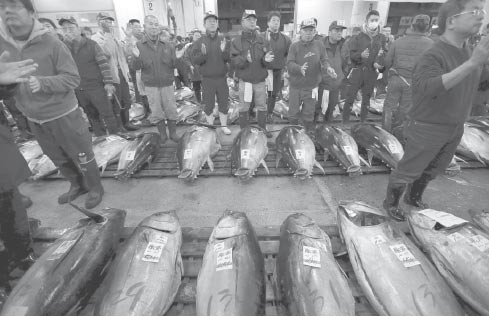80-year-old fish market holds final New Year auction
( Agencies ) Updated: 2016-01-16 10:55:49
The world's biggest and most famous fish and seafood market-also a major tourist attraction in Tokyo-is due to move in November to a massive complex further south in Tokyo Bay, making way for redevelopment of the prime slice of downtown real estate.
The closure of the Tsukiji market will punctuate the end of the post-war era for many of the mom-and-pop shops just outside the main market that peddle a cornucopia of sea-related products, from dried squid and seaweed to whale bacon and caviar.
The auction is typical of Japan's penchant for fresh starts at the beginning of the year-the first visit of the year to a shrine and the first dream of the year are other important firsts-and it's meant to set an auspicious precedent for the 12 months to come.
Sushi restaurateur Kiyoshi Kimura has prevailed in most of the recent new year auctions, and he did so again this year in the bidding for a 200-kilogram tuna.
In 2013, a bidding war drove his record winning bid to 154.4 million yen (at today's exchange rates about $1.3 million) for a 222-kilogram fish.
That drew complaints that prices had soared way out of line, and the winning price in 2014 was dramatically lower. Last year, a 180.4-kilogram tuna caught off Japan's northern region of Aomori fetched a winning bid of 4.51 million yen ($37,480).
Japanese eat about 80 percent of all bluefin tuna caught worldwide, and stocks of all three bluefin species-the Pacific, Southern and Atlantic-have fallen over the past 15 years amid overfishing.
But while the new year and daily tuna auctions are Tsukiji's best-known events, the market is about much more than just tuna.
|
|
|
|
|
|
|
|


























 Raymond Zhou:
Raymond Zhou: Pauline D Loh:
Pauline D Loh: Hot Pot
Hot Pot Eco China
Eco China China Dream
China Dream China Face
China Face






